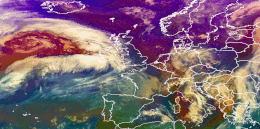Storm Eleanor (2018)
 Satellite animation of Eleanor's lifetime over Western Europe (Seviri RGB Airmass view) | |
| Type | Extratropical cyclone European windstorm |
|---|---|
| Duration | 2–4 January 2018 |
| Highest gust | 226 km/h (140 mph), Goldau[1] (alt 578 m [1,896 ft]) |
| Lowest pressure | 966 hPa (28.5 inHg)[2] |
| Fatalities | 6[3] |
| Damage | Initial €643 million insured loss.[3] |
| Power outages | ~150000 customers in Republic of Ireland affected[4] |
| Areas affected | Austria, Belgium, France, Germany, Ireland, Luxembourg, the Netherlands, Switzerland, and the United Kingdom |
Part of the 2017-18 European windstorm season | |
Storm Eleanor (known as Cyclone Burglind in Germany) was an extratropical cyclone and European windstorm that affected Ireland, the United Kingdom, France, Benelux, Germany, Austria and Switzerland on the 2–3 January 2018. The storm caused extensive damage and traffic disruption. It was given the name Eleanor by Met Éireann and the UK Met Office, while the Free University of Berlin named the low pressure Burglind.
Meteorological history
[edit]Eleanor developed to the west of Ireland as a secondary cyclone on 2 January to the parent low "Alja" to the southwest of Iceland, developing as a wave along the trailing cold front of the parent low.[2] Eleanor rapidly intensified reaching a minimum pressure of 966 hPa (28.5 inHg) as it moved east across Scotland under a strong westerly jet stream.[2] Before the low centre tracked across the North Sea to Denmark. To the south of the central low Eleanor caused strong winds which covered a large footprint of across much of western Europe.[2]
The ECMWF operational forecast model of maximum winds featured a narrow corridor of strong winds crossing Ireland and Northern Ireland, which they suggested could be indicative of a Sting jet.[5]
Impact
[edit]This section is empty. You can help by adding to it. (January 2021) |

Highest wind gust per country
[edit]| Country | Gust | Location |
|---|---|---|
| 206 km/h (128 mph) | Arlberg | |
| 145 km/h (90 mph) | St. Vith | |
| 177 km/h (110 mph) | Pointe du Raz | |
| 160 km/h (99 mph) | Brocken | |
| 146 km/h (91 mph) | Rosslare Harbour | |
| 207 km/h (129 mph) | Dolomites | |
| 105 km/h (65 mph) | Wiltz | |
| 141 km/h (88 mph) | Vlissingen | |
| 226 km/h (140 mph) | Goldau | |
| 193 km/h (120 mph) | Glen Coe |
See also
[edit]References
[edit]- ^ "Windböen, 1std, Messwerte Zug vom 03.01.2018, 12:00 Uhr" [Wind gusts, 1 hour, measured values in Zug, 3 January 2018, 12:00 p.m.] (in German). Retrieved 27 February 2018.
- ^ a b c d Holland, Peter (17 January 2018). "Eleanor/Burglind: Another "Near-miss" for Europe?". www.rms.com. Retrieved 17 January 2018.
- ^ a b "Perils Puts Initial Loss Estimate for Extratropical Cyclone Burglind (Eleanor) at EUR 643M" (PDF). Perils.org. 13 February 2018. Retrieved 15 February 2018.[permanent dead link]
- ^ "Crews continue to restore power to customers affected by Storm Eleanor". www.esbnetworks.ie. Archived from the original on 4 January 2018. Retrieved 3 January 2018.
- ^ @ECMWF (5 January 2018). "The maximum modelled wind gusts during #StormEleanor at the beginning of January are shown. The fact that a narrow strong wind "corridor" extends inland (Ireland and N Ireland in this case) can be one signature of a sting jet" (Tweet) – via Twitter.

